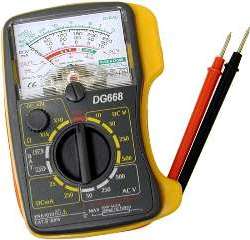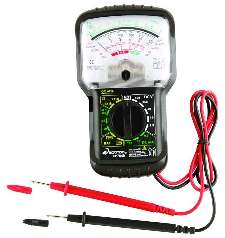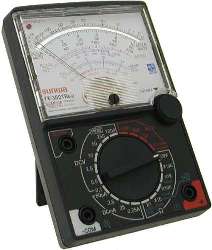The MGA With An Attitude
MULTI-METER, ANALOG -- TS-113A
 The prominent feature of the analog multi-meter is the galvanometer, or moving needle volt meter display. Don't expect these things to be real small, because there is a advantage to a big meter dial for accuracy and visibility. The cheap ones can be as low as $5 to $20-USD. For under $10 then sort of work, but may be quite small, hard to read, not so accurate, possibly fragile, and the test leads will be short. In the $15-$20 range you can get a serviceable meter a little more durable, but do take a good look at the plastic housing and dial window before buying one. Flat face and sharp corners may be easy to scratch or break. Thicker window and rounded corners should be sturdier. Professional versions may sell for hundreds of dollars, but you don't need that for occasional home use.
The prominent feature of the analog multi-meter is the galvanometer, or moving needle volt meter display. Don't expect these things to be real small, because there is a advantage to a big meter dial for accuracy and visibility. The cheap ones can be as low as $5 to $20-USD. For under $10 then sort of work, but may be quite small, hard to read, not so accurate, possibly fragile, and the test leads will be short. In the $15-$20 range you can get a serviceable meter a little more durable, but do take a good look at the plastic housing and dial window before buying one. Flat face and sharp corners may be easy to scratch or break. Thicker window and rounded corners should be sturdier. Professional versions may sell for hundreds of dollars, but you don't need that for occasional home use.


It is important to show these with the test leads, as the test probes may be as long as the height of the instrument, and longer wires are a fidget to pack for traveling. The analog meter almost never comes with a cover or carrying case unless you make a point of buying one separately. The one shown at top of page has the wire leads nested in a groove wrapped around the perimeter of the instrument, and the test probes can snap into the side of the case. That's about as friendly as they come for neatness and storage. If you contemplate carrying one of these in your traveling tool kit, figure on putting it in a thick plastic baggie or a vinyl cover. For me the analog multi-meter is a stay at home tool.
The reason for having an analog multimeter is primarily to be able to watch resistance and voltage fluctuations on the fly. When testing and adjusting a voltage regulator for a generator, as engine speed increases the voltage rises to a preset point and then drops back just a little and stabilizes. It is very difficult to see the gradual rise and the break point when using a digital meter. Also the rapid on-off switching of contact points in an analog voltage regulator may drive a digital meter nuts, especially when measuring field voltage. When testing a fuel level sender unit the resistance rises and falls with motion of the float arm, and any discontinuity in the wiper arm contact should show itself as an erratic jumping of the analog meter needle while in motion.
|